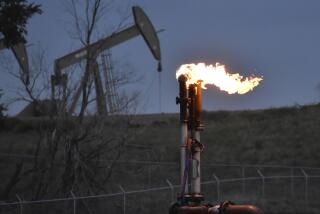Bugs could clean up oil industry
- Share via
CALGARY, CANADA — A tiny oil-eating bug that lives deep underground might allow the world’s oil industry to unlock energy trapped in trillions of barrels of heavy crude, which is costly and dirty to produce using today’s methods.
British, Canadian and Norwegian researchers have shown how microbes in oil reservoirs break down crude and release methane gas, a discovery that could spur much more environmentally friendly energy production as resources get more scarce.
The trick now is to pump up the organisms with the equivalent of steroids so they can perform their task in 10 years instead of 10 million, said University of Calgary geologist Steve Larter. The study was published in the science journal Nature.
The result: the ability to produce natural gas from oil reservoirs, rather than burning it from conventional sources to aid production of gooey heavy crude.
“If it can be done economically, that’s a game-changer, because the average heavy oil recovery worldwide is 17%,” Larter said. “If you can suddenly liberate a tiny additional fraction of that as methane rather than as heavy oil, with all of its environmental and cost footprint, then it’s a huge thing.”
The process of “feeding” the microbes nutrients works in the laboratory, but it is not known yet if it can be done over the expanse of an oil field, he said.
Still, some major oil companies, faced with spiraling costs and environmental headaches as they try to coax more of the poorer quality, cheaper crude from the ground, are taking notice, Larter said. He declined to name them.
Over the years, the industry has come close to exhausting reserves of easy-to-find and valuable light oil, which needs the least refining to turn it into gasoline and other fuels.
Now, companies are faced with having to pump, or even mine, an estimated six trillion barrels of thick heavy oil and oil sands crude, which is far more costly and ecologically damaging to produce but sells for a discount in the market.
It is conceivable that converting 20% of a giant, billion-barrel heavy oil field could yield one trillion cubic feet of methane, which would rival some of the largest recent conventional gas finds in size, Larter said.
The team, which includes petroleum geologists, microbiologists and organic geochemists, is aiming for field tests within the next year.
More to Read
Sign up for Essential California
The most important California stories and recommendations in your inbox every morning.
You may occasionally receive promotional content from the Los Angeles Times.









